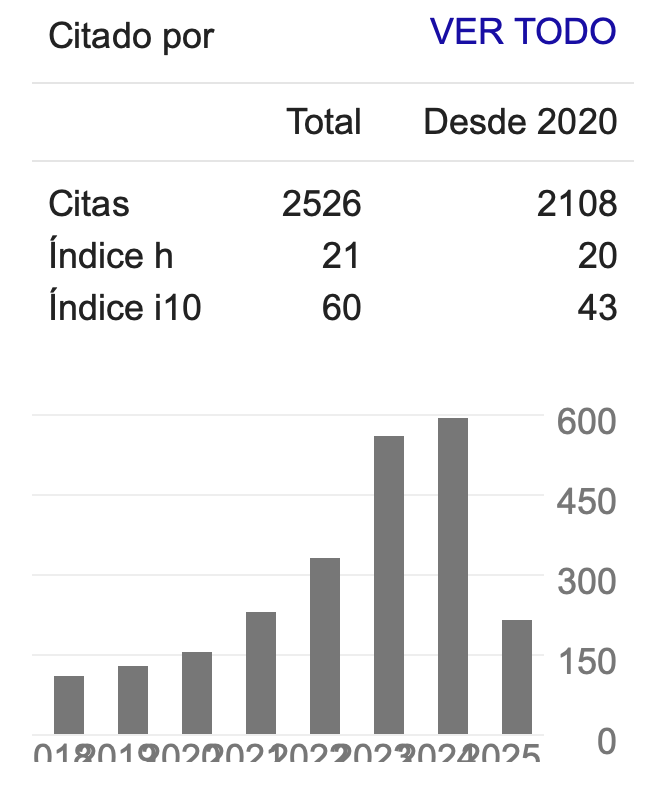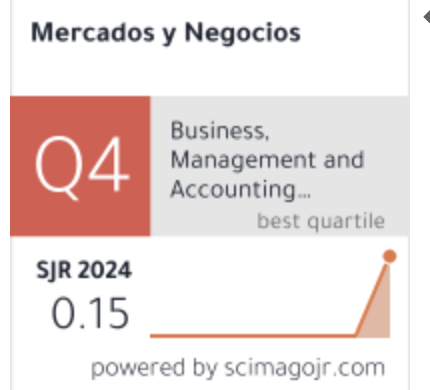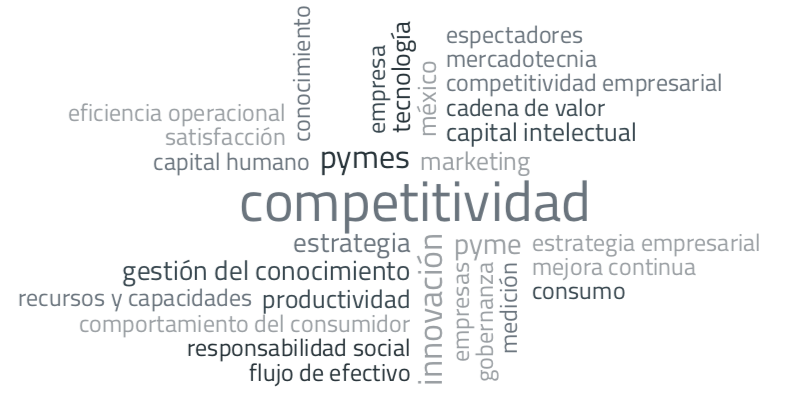Worth and Competitiveness in Spain’s Furniture Sector
DOI:
https://doi.org/10.32870/myn.v0i20.5119Keywords:
Experience, abilities, education, performance, worth, competitivenessAbstract
This paper has as main objective to analyze the effects of the manager’s worth in the competitiveness of the Spain furniture sector. The empiric analysis was done on a sample of 322 furniture producing companies in Spain with twenty or more employees. The results show the experience, abilities and the education have a positive impact in the manager’s performance. Also, the performance has a positive impact in the manager’s worth and this has a positive impact in the competitiveness of the companies that integrate the furniture sectorReferences
Abdur Razzaque, M., & Shafreen Bin Sirat, M. (2001). Skill requirements: perception of the senior Asian logisticians. International Journal of Physical Distribution & Logistics Management, 31(5), 374-395.
Alan M.. Rugman, & Hodgetts, R. M. (2000). International Business: A Strategic Management Approach. Financial Times/Prentice Hall.
Anderson, J. C., & Gerbing, D. W. (1988). Structural equation modeling in practice: A review and recommended two-step approach. Psychological bulletin, 103(3), 411.
Bagozzi, R. P., & Yi, Y. (1988). On the evaluation of structural equation models. Journal of the academy of marketing science, 16(1), 74-94.
Barney, J. (1991). Firm resources and sustained competitive advantage.Journal of management, 17(1), 99-120.
Barry, D., Cramton, C. D., & Carroll, S. J. (1997). Navigating the garbage can: How agendas help managers cope with job realities. The Academy of Management Executive, 11(2), 26-42.
Bentler, P. M., & Wu, E. J. (2005). EQS 6.1 for Windows. Structural equations program manual. Encino, CA: Multivariate Software.
Beyer, J. M., Chattopadhyay, P., George, E., Glick, W. H., & Pugliese, D. (1997). The selective perception of managers revisited. Academy of Management Journal, 40(3), 716-737.
Blankenship, A. B., & Taylor, H. R. (1938). Prediction of vocational proficiency in three machine operations. Journal of applied psychology, 22(5), 518.
Bowersox, D. J., Closs, D. J., & Stank, T. P. (2000). Ten mega-trends that will revolutionize supply chain logistics. Journal of business logistics, 21(2), 1.
Brown, T. A. (2006). Confirmatory factor analysis for applied researchers.
Buckley, P. J., Pass, C. L., & Prescott, K. (1988). Measures of international competitiveness: A critical survey∗†. Journal of marketing management, 4(2), 175-200.
Burcher, P. G., Lee, G. L., & Sohal, A. S. (2007). Production and operations managers and logistics managers: a cross-country comparison. Journal of Manufacturing Technology Management, 18(5), 549-560.
Buxbaum, P. A. (1995). The next generation of logistics managers: fearless communicators. Transportation and distribution, 36(10), 84-85.
Byrne, B. M. (2006). Structural equation modeling with EQS: Basic concepts, applications, and programming .
Carroll, S. J., & Gillen, D. I. (1987). Are the classical management functions useful in describing managerial work?. Academy of management review, 12(1), 38-51.
Casson, M. (1991). Global research strategy and international competitiveness. B. Blackwell.
Chou, C. P., Bentler, P. M., & Satorra, A. (1991). Scaled test statistics and robust standard errors for non‐normal data in covariance structure analysis: a Monte Carlo study. British Journal of Mathematical and Statistical Psychology,44(2), 347-357.
Daugherty, P. J. (2000). Linking compensation and retention. SUPPLY CHAIN MANAGEMENT REVIEW, V. 4, NO. 3 (JULY/AUGUST 2000), P. 64-72: ILL.
Faulkner, D., & Bowman, C. (1995). The essence of competitive strategy. Upper Saddle River, NJ: Prentice Hall.
Fleishman, E. A. (1965). Attitude Versus Skill Factors In Work Group Productivity1. Personnel Psychology, 18(3), 253-266.
Fornell, C., & Larcker, D. F. (1981). Evaluating structural equation models with unobservable variables and measurement error. Journal of marketing research, 39-50.
Ginter, J. L., & LaLonde, B. J. (2003). The Ohio State University 2003 survey of career patterns in logistics. In Annual conference proceedings of the council of logistics management.
Goleman, D. (2003). What makes a leader. Organizational influence processes, 229-241.
Gorynia, M. (2005). Competitiveness of firms from Ziemia Lubuska and Poland's accession to the European Union. Journal for East European Management Studies, 195-217.
Prahalad, C. K., & Hamel, G. (1990). The Core Competence of the Corporation.Harvard Business Review, 68(3), 79-91.
Herron, D. P. (1985). The educational needs of physical distribution managers.The distribution handbook, 849-855.
Hill, C. W., & Jones, G. R. (1998). Strategy management theory: An integrated approach. Boston, MA: Hounghton Mifflin Company,.
Hu, L. T., Bentler, P. M., & Kano, Y. (1992). Can test statistics in covariance structure analysis be trusted?. Psychological bulletin, 112(2), 351.
Hunt, S. D., & Morgan, R. M. (1995). The comparative advantage theory of competition. The Journal of Marketing, 1-15.
Ireland, R. D., Hitt, M. A., Camp, S. M., & Sexton, D. L. (2001). Integrating entrepreneurship and strategic management actions to create firm wealth. The Academy of Management Executive, 15(1), 49-63.
Kohn, J. W., McGinnis, M. A., & Kesava, P. K. (1990). Organisational environment and logistics strategy: an empirical study. International Journal of Physical Distribution & Logistics Management, 20(2), 22-30.
LaLonde, B. J. (1990). Update logistics skills for the future. Transportation and Distribution, 31(1), 46-8.
LaLonde, B. J., & Emmelhainz, L. W. (1985). Where do you fit in?. Distribution,8, 34.
LaLonde, B. J., & Pohlen, T. L. (1999). The Ohio State University 1999 Survey of career patterns in logistics. In Annual Conference Proceedings 1999.
McClelland, D. C. (1973). Testing for competence rather than for" intelligence.".American psychologist, 28(1), 1.
McDaniel, M. A., Schmidt, F. L., & Hunter, J. E. (1988). Job experience correlates of job performance. Journal of Applied Psychology, 73(2), 327.
Mintzberg, H., & Westley, F. (2001). Decision making: It's not what you think.MIT Sloan Management Review, 42(3), 89.
Murphy, P., & Poist, R. F. (2007). Skill requirements of senior-level logisticians: a longitudinal assessment. Supply Chain Management: An International Journal, 12(6), 423-431.
Myers, M. B., Griffith, D. A., Daugherty, P. J., & Lusch, R. F. (2004). Maximizing the human capital equation in logistics: education, experience, and skills. Journal of Business Logistics, 25(1), 211-232.
Poist, R. F., Scheraga, C. A., & Semeijn, J. (2001). Preparation of logistics managers for the contemporary environment of the European Union.International Journal of Physical Distribution & Logistics Management, 31(7/8), 487-505.
Porter, M. (1990). The Competitive Advantage of Nations.
Porter, M. E. (1998). Cluster and the new economics of competition.
Quayle, M. R., & Jones, B. (2001). Logistics: an integrated approach. Liverpool Academic Press.
Richardson, H. L. (1996). CAREER UPDATE--LOGISTICS IN THE LIMELIGHT.TRANSPORTATION & DISTRIBUTION.
Richardson, H. L. (1991). Boost your career with business skills. Transportation and Distribution, 32(6), 26-29.
Rumelt, R. P. (1997). Towards a strategic theory of the firm. Resources, firms, and strategies: A reader in the resource-based perspective, 131-145.
Sandberg, J. (2000). Understanding human competence at work: an interpretative approach. Academy of management journal, 43(1), 9-25.
Schmidt, F. L., Hunter, J. E., & Outerbridge, A. N. (1986). Impact of job experience and ability on job knowledge, work sample performance, and supervisory ratings of job performance. Journal of applied psychology, 71(3), 432.
Schmidt, F. L., Hunter, J. E., Outerbridge, A. N., & Goff, S. (1988). Joint relation of experience and ability with job performance: Test of three hypotheses. Journal of Applied Psychology, 73(1), 46.
Singer, M. S., & Bruhns, C. (1991). Relative effect of applicant work experience and academic qualification on selection interview decisions: A study of between-sample generalizability. Journal of applied psychology, 76(4), 550.
Stalk, G., Evans, P., & Shulman, L. E. (1992). Competing on Capabilities: The New Rules of.
Stock, J. R., & Lambert, D. M. (1987). Strategic Logistics Management . Homewood IL: Richard D. Irwin. Inc.,.
Taylor, J. G., & Smith, P. C. (1956). An investigation of the shape of learning curves for industrial motor tasks. Journal of applied psychology, 40(3), 142.
Waldman, D. A., Ramirez, G. G., House, R. J., & Puranam, P. (2001). Does leadership matter? CEO leadership attributes and profitability under conditions of perceived environmental uncertainty. Academy of management journal,44(1), 134-143.
Wanke, P. F., & Zinn, W. (2004). Strategic logistics decision making.International Journal of Physical Distribution & Logistics Management, 34(6), 466-478.
Wierenga, B., & Van Bruggen, G. H. (1997). The integration of marketing problem-solving modes and marketing management support systems. The Journal of Marketing, 21-37.
Zimmerman, E. (2001). What Are Employees Worth? You get this question all the time: if we invest dollars in employee development, will it mean more money on the bottom line?. WORKFORCE-COSTA MESA-, 80(2), 32-37.
Downloads
Published
How to Cite
Issue
Section
License
Mercados y Negocios by Department of Mercadotecnia y Negocios Internacionales. University of Guadalajara is licensed under a License Creative Commons Attribution-NonCommercial 4.0 International.
The author retains the copyright.








